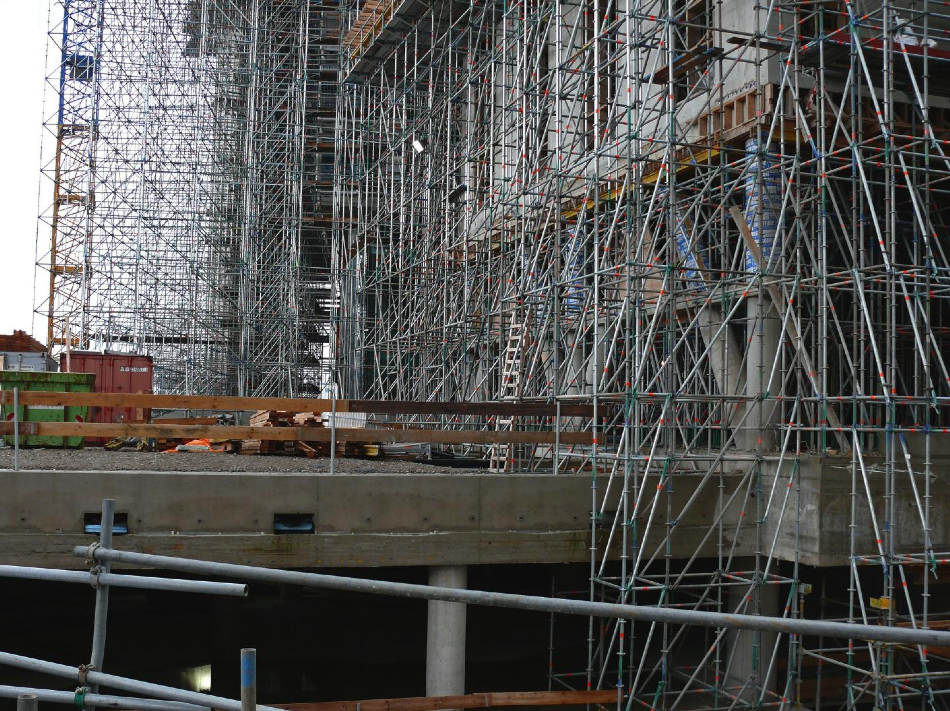Mar 2 2020
At the Far Eastern Federal University Military training center (FEFU, Vladivostok, Russia), engineers collaborated with their colleagues from RUDN University to create a concrete mixture with nano additives for monolithic construction up to a height of 10 stories.
 A close-up view on huge scaffolding at the construction site for building the new Municipal Library. At the left, the thick layers of scaffolds are necessary to support the forward horizontally front-facade. Image Credit: Fons Heijnsbroek, Unsplash.
A close-up view on huge scaffolding at the construction site for building the new Municipal Library. At the left, the thick layers of scaffolds are necessary to support the forward horizontally front-facade. Image Credit: Fons Heijnsbroek, Unsplash.
The concrete can be cast at a negative temperature down to −5 °C and a very humid climate, since the constructed buildings would not necessitate a major renewal for five decades. The paper related to the study was recently published in the Construction and Building Materials journal.
For the construction industry, it is a major difficulty to cast concrete under low-temperature conditions. The presence of water in the concrete freeze could affect the fluidity of the concrete, which will affect its curing and lead to the formation of in-slab lumps. Exclusive technology is already necessary to cast cement at temperatures below +5 °C. Violation of one leads to reduced characteristics of monolithic structures that run down too soon.
FEFU Military training center (MTC) engineers, in collaboration with their collaborators from RUDN University, proposed the addition of special additives (super plasticizers) into the concrete mix, where the properties of the additives are enhanced through nanotechnology. The advancement helps to keep the durability and strength of concrete structures constructed during the cold season, thereby preventing an increase in the construction cost.
The characteristics of the new nano mixture meet the needs of civil engineering and generally exceed regulatory requirements. The mixture is suitable for casting of civil structures up to 10 stories high under humidity conditions. That makes it relevant for construction in humid continental, monsoon and moderately cold climate.
Roman Fediuk, Lt. Col., Research Author and Professor, Far Eastern Federal University
Fediuk added, “The mixture is curing quickly, the outcoming concrete slab has a dense structure with no lumping and with a pore size smaller than in conventional concrete. Thus, moisture, which destroys ordinary concrete, not capable of penetrating the new one. The properties of concrete slab remain unchanged for 50 years.”
Roman Fediuk is also the winner of the XIII All-Russian contest “Engineer of the Year 2018.”
The researcher thought that in the novel concrete mixture, similar to earlier developments, less cement was replaced with ash from energy production and screenings of crushing sand that renders concrete eco-friendly. Thus, the technological properties of the novel mixture are similar to the mixtures including high-grade cement, which makes the development more economical.
Engineers empirically determined the proportions of the altered additives; subsequently, mathematical models were applied to fine-tune the calculations. The mixture with such an established composition withstands the frost and prevents an increase in fluidity that leads to in-slab lumping of concrete (segregation) at low temperatures and a drop in the strength of the cast structure.
Furthermore, nearly 40% less water was used by the engineers in the mixture, thereby enhancing the density and strength of the concrete slab. Gel pore size and high density are realized not just by using nano-additives but also through the technology of further grinding of concrete particles. Researchers at FEFU also created a grinder.
The novel mixture was given a test-drive earlier. As part of field research, a five-story parking lot was constructed by the engineers. The concrete stone was left to cure for 28 days under normal conditions, with temperature differences ranging from +5 to −5 °C. The outcomes were in agreement with the proposed standards.
The researchers used popular components in the construction industry as additives, where the properties of the components were enhanced by using nanoparticles. As a result, naphthalene formaldehyde resin has been strengthened by the properties of silicon dioxide, and the resulting concrete was stronger and maintained operational characteristics for a longer period. Sodium nitrate and saponified wood resin were also used as the components of the mixture.
A scientific school has been set up at the FEFU MTC for the advancement of intelligent composites for special and civil engineering, the main idea of which is to develop artificial materials quite similar to the natural ones. For instance, concrete should match the strength of natural stone.
This theory has been developed by modern science, Geonics (Geomimetics), established by professor Valery Lesovik of V.G. Shukhov Belgorod State Technological University, a corresponding member of the Russian Academy of Architecture and Construction Sciences.
Engineers from Kazan, Moscow, and the Russian Far East have been contributing toward the advancement of the technology. The design of the novel concrete complies with the principles of geomimetics. Its ultimate aim is to design novel materials to ensure a convenient human environment.
The further step of the study would be to create a concrete mixture that can be cast under negative temperatures down to −15 °C.